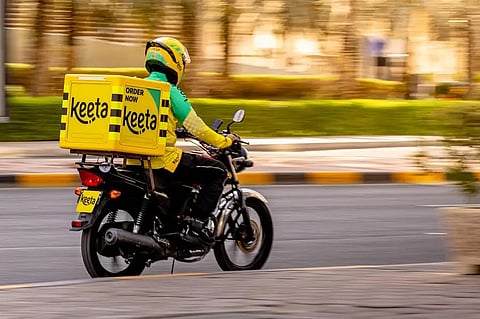Why are we suddenly seeing so many Keeta food delivery riders in Dubai?
Inside the strategy powering Keeta’s rapid rise — and what it means for Dubai’s streets

Dubai: If you’ve noticed more food delivery bikes cutting through Dubai traffic lately, you’re not imagining it. The number of riders has jumped sharply in recent months — the result of a rapid recruitment wave led by Keeta, a food delivery platform expanding aggressively across the city.
This surge isn’t random. It’s the product of a well-funded regional strategy, a major local partnership, and a changing labour market that’s drawing in thousands of new applicants for motorcycle licences.
Stable new phase
Driving centres in Dubai have seen a steady rise in motorcycle licence applications from food delivery companies since mid-2024. The increase signals a lasting shift, not just another short-term gig-economy spike.
Dr Suzanne Accetta, CEO of First Driving Centre, says the trend marks the start of a more structured stage for delivery work. “We’ve seen a clear uptick.
"This growth builds on the strong post-COVID demand but represents a new, stable phase. It’s driven by steady recruitment from delivery companies and better working conditions for riders, moving beyond short-term economic fluctuations.”
She says stronger competition between platforms is transforming the job market. “The entry of new platforms like Keeta is fueling strong competition for riders. This has led to improved pay scales and structured benefits, encouraging more job seekers to invest in a licence.”

Recruitment agencies have broadened their search to keep up with demand. “Applications show a broad mix,” Dr Accetta said, “but are predominantly from India, Pakistan, Nepal, and Sri Lanka, with a notable increase from African countries.”
Gulf-tested playbook
Keeta’s rise in Dubai is part of a regional rollout strategy that’s being executed across the Gulf.
The platform launched its first Middle East operation in Saudi Arabia in September 2024, followed by Qatar in August 2025 and Kuwait in September 2025. Its UAE expansion in 2025 builds on the lessons learned from those markets — where the company used aggressive customer incentives, free delivery, and merchant onboarding programmes to capture attention quickly.
A recent Morgan Stanley research note said Keeta plans to fully cover all six Gulf countries, adding Bahrain and Oman to its existing footprint in Saudi Arabia, the UAE, Qatar, and Kuwait.
That wider plan reflects the ambitions of its parent company, Meituan International, which operates one of the world’s largest on-demand delivery networks, handling more than 150 million daily orders. The GCC expansion is designed to replicate Meituan’s scale and efficiency across the region’s fast-growing delivery economies.
Partnering for scale
In Dubai, Keeta’s most significant move has been its strategic partnership with Dubai Taxi Company (DTC) — a deal that immediately expanded its fleet and ensured regulatory compliance from day one.
Under the agreement, DTC deployed an initial 150 delivery motorbikes, with plans to scale up to 500 by the end of 2025. The partnership is expected to generate over Dh10 million in revenue in the first year, while DTC’s delivery-bike segment revenue already surged 102 percent year-on-year to Dh18.2 million in Q2 2025.
DTC CEO Mansoor Rahma Alfalasi then reaffirmed that the partnership “diversifies our services, maximises fleet potential, and positions DTC at the forefront of next-generation logistics.”
Better pay, conditions
Improved working conditions are also driving the influx of new riders. While companies rarely disclose exact pay figures, the message from recruiters and training centres is consistent: compensation, structure, and benefits have improved.
Keeta’s logistics technology, inherited from Meituan’s operations in Asia, enables more efficient route management, allowing riders to complete more deliveries per hour — and potentially earn more overall.
Cynthia Chen, General Manager of Keeta UAE, said the platform’s approach centres on reliability and user trust. “The UAE brings together a diverse community that values trust, speed, and simplicity, and our goal is to meet those expectations consistently.”
For many riders, this structured model — clearer pay breakdowns, better scheduling, and more predictable income — is changing the perception of delivery work itself.
UAE food delivery boom
The UAE’s food delivery market is forecast to exceed Dh5 billion in 2025, underscoring how deeply delivery culture has embedded itself into daily life.
However, the surge of riders now visible on Dubai’s streets signals something broader — a professionalisation of the workforce behind the city’s on-demand economy.
Dr Accetta sees this as a sustained, long-term transformation. “This isn’t just a spike,” she said. “It’s a structured, sustained phase in the delivery workforce — one where riders see real opportunity, not just necessity.”
Bigger boon for Dubai?
The rise in delivery bikes reflects bigger shifts — companies are hiring more systematically, training riders better, and working with the government to improve the system.
Keeta’s growth shows that global delivery systems can easily fit the Gulf market — and that Dubai is quick to make them work. As the company prepares to expand across the rest of the GCC, the UAE’s delivery economy is entering a new era — faster, more connected, and increasingly central to everyday urban life.
Sign up for the Daily Briefing
Get the latest news and updates straight to your inbox



